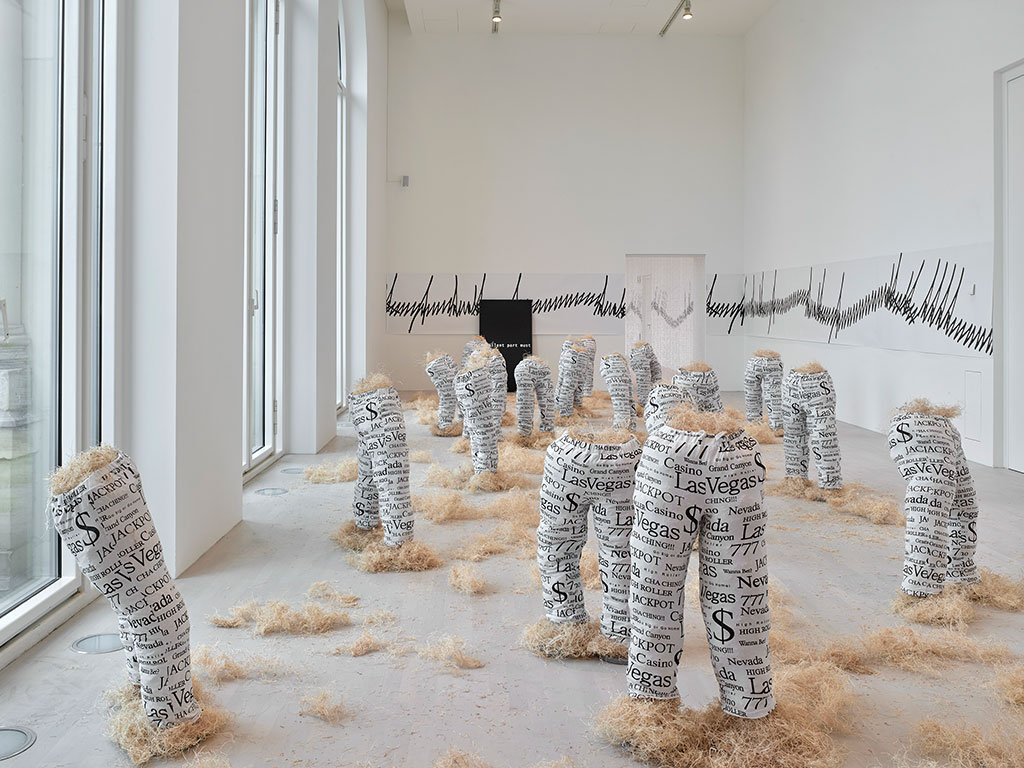The American artist Lutz Bacher – who has concealed her identity beneath a masculine pseudonym throughout her career – works conceptually in a range of media. A longtime resident of California who now lives in New York, the artist has based her work since the 1970s on found objects as well as texts and images pulled from the minutiae of popular culture.
Soundtracks from Hollywood films, props from television shows, and unedited cell phone videos find their way into her works along with discarded objects from different spheres of consumption. Through techniques of rearrangement, distortion, and estrangement, Bacher destabilizes the appearance and alters the impact of her materials, creating ruptures and making new constellations possible. Addressing the strong influence of the mass media on everyday social and political life, issues of identity, power structures, and violence are central aspects of her artistic practice. Now, for her exhibition at the K21, “What’s Love Got to Do With It,” new and recent work by Bacher is presented on the Bel Etage and in the entrance hall of the museum.
With a stylistically eclectic approach to appropriation and the deployment of readymades, the artist disturbs the status of so-called originals, interrogating authorship and the constitution of artworks. Consequently, the functions of images and language are questionable under Bacher’s influence as both are frequently distended and made strange. In “Untitled” (2017), Donald Trump’s signature is enlarged and manipulated to create a line of cursive that snakes across all three of the exhibition’s galleries.
Hastily scribbled notes from everyday life and ostensibly meaningful, zen-inspired sentences pass by in an endless loop on giant screens (“Open the Kimono”, 2018; “Black or White”, 2018). Together with “The Sea. Spies Like Us” (2013), a sporadically intelligible soundscape of audio excerpted from a spy thriller, these elements densify into an atmosphere of ambivalence that evokes the cacophony of everyday life through its never-ending stream of information.
Lutz Bacher’s art is paradoxical in nature, combining humor with sharp criticism. Through tragicomedy, the fragility of our existence and the contradictions of social conventions are revealed. Turning the mythologized cowboys of the Vegas Strip into straw men, the installation “Vegas Pants” (2018) is composed of a group of pyjama bottoms emblazoned with the name of the titular desert city and gambling mantras, the tacky residue of get-rich-quick clichés of the American West filled only with air and straw.
An example of Bacher’s ongoing interest in the blurred boundaries between public and private is “Cyclops” (2017), an arrangement of 26 surveillance mirrors in the entrance hall of the museum. The work channels the omnipresence of surveillance technologies, disciplinary techniques, and the powers they both enable and conceal. Installed in an architecturally erratic setting, the mirrors form a similarly chaotic system of reflections and sightlines. At the same time as they repel probing looks, they allow a multitude of new perspectives from which the surrounding space can be viewed.
Time and again, the artist generates productive tensions through the juxtaposition of opposites, from black and white to the sublime and the everyday. Playing every hour in the museum piazza is “Music in the Castle of Heaven” (2018), a smartphone recording of a church concert of Johann Sebastian Bach’s famous organ piece, “Toccata and Fugue in D Minor”. This often sampled composition permeates the entire building with sacred resonance, making the museum space aesthetically tangible in a new way.
Lutz Bacher’s works reject a desire for easy interpretation. Instead, they remain inconclusive and enigmatic. Connections seem to arise and then a moment later disappear. In viewing Bacher’s art, the contradictions and ambiguities of our own experience and variable approaches to finding meaning are what we are left with; the artist forces us to plumb the gaps in our understanding and dig associative holes as they repeat on loop.

